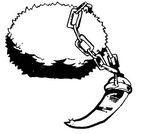How to Remember Anything: The Proven Total Memory Retention System (16 page)
Read How to Remember Anything: The Proven Total Memory Retention System Online
Authors: Dean Vaughn
37.
See a gigantic
nickel
bursting out of location 37—the back right corner of your 30s room. The nickel has a
sh
i
p (69)
bursting through it!
Nixon:
19
69.
38.
See a
Ford
bursting out of location 38—the back wall of your 30s room. The Ford has a gigantic
c
o
r
e
(74)
bursting through the roof of it!
Ford:
19
74.
39.
See a gigantic
cart
(a grocery cart) at location 39—the floor of your 30s room. The cart has a huge
c
a
k
e
(77)
in it!
Carter:
19
77
.
40.
See a gigantic
ray gun
(a gun that shoots rays) at location 40—the ceiling of your 40s room. The ray gun has a
f
oo
t
(81) coming out of it!
Reagan:
19
81.
41.
See a gigantic
bush
growing at location 41—the back left corner of your 40s room. The bush has a huge
f
o
b (89)
hanging on it!
Bush:
19
89.
42.
See a
clinic
at location 42—the left wall of your 40s room. The clinic has a gigantic
p
o
m-
pom
(93)
sticking out of it!
Clinton:
19
93.
43.
See a gigantic
bush
growing at location 43—the front left corner of your 40s room. The bush has a
s
ui
t (01)
hanging on it!
Bush:
20
01.
You have now seen how it is possible to learn information in sequence and also link other information to it. Again, you may not be interested in this particular information, but you should complete enough of the exercise to learn how to remember this type of information. There are many practical applications for this combination of techniques.
If you are learning the basic history of any nation, there are only three things you need to know to give you the entire chronological history of that nation. These things should be learned in sequence, beginning at the time that country came into being:
Who
were the leaders?
When
were they the leaders?
What
happened when they were the leaders?
If you know these things, you will know more about the history of the nation than most well-educated natives of that country.
I recognize the value of knowing why certain historical events occurred. If desired, the
why
things happened could be added to the who, when, and what listed earlier. The important thing is that there is now an organized and effective way to quickly learn and remember the history of any nation.
In the case of the history of the United States, you can see how easy it is to learn the who and the when for all the presidents. The what happened could easily be added by using the Link system to include as many events as you wish. If you add the major historical events that occurred during each president’s term of office, you would know the chronological history of the United States.
All of this information could be taught in a tiny fraction of the time it now takes to teach even a small part of it. I hope that because of the learning strategies you are discovering, tomorrow’s students may be knowledgeable in the science of memory. If so, they could be taught with organized learning systems and will remember what they learn. Otherwise, learning by the inefficient method of repetition will continue.
THE KEY WORD SYSTEM (00–99)
You have already learned how to develop Code Words from numbers by
using the Number Code. There are several advantages to having a Key Word that you always think of first for a number. A Key Word is a Code Word but, more than that, it is your favorite word (the one you consistently use for a particular number).
You should now develop Key Words for the numbers 00 through 99. In selecting your Key Words, you should choose the most common word for each of the 100 numbers.
I suggest that you use the following Key Words. If you wish to use any other word for a specific numbers, please be certain that you have a clear visual image of the object represented by the Key Word and that it does not cause any confusion with another Key Word. You will use the Key Words every day in practical applications of the system. I will give you two sets of Key Words. The first set is for the single-digit numbers 0 through 9.
0 = S, C (soft), Z
1 = T, D, TH
2 = N
3 = M
4 = R
5 = L
6 = CH, SH, G (soft), J
7 = C (hard), K, G (hard), Q
8 = F, V, PH
9 = P, B
Following is a list of Key Words for all the single-digit numbers. Select just one word for each number and then always use that as your Key Word. Please note that the single-digit numbers are more difficult because each word must have only one consonant sound.
| 0 | se a, s ew (a needle), i c e, z oo, ho s e |
| 1 | t ea, t ie, t oe t ow (a tow truck), ha t |
| 2 | N oah (Noah’s ark), k n ee, he n |
| 3 | M a, m ow (a lawn mower), ha m |
| 4 | r ye, hai r |
| 5 | l ei, l aw (a gavel), hai l |
| 6 | Sh oe, ha sh |
| 7 | k ey, hoo k |
| 8 | f oe (a competitor), hoo f , hal f (a half-dollar). Please note that the l is silent. |
| 9 | p ie, p ea, hoo p |






